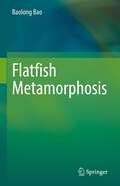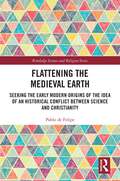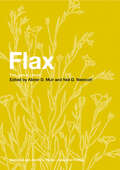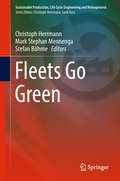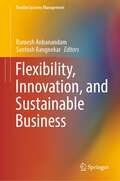- Table View
- List View
Flatfish Metamorphosis
by Baolong BaoThis book provides a comprehensive discussion of the development and evolution of flatfish metamorphosis. The chapters use the tissue model to explain a series of metamorphic events, including eye migration, front bone deformation, dorsal fin elongation and regression, and body depth change, left/right asymmetrical pigmentation, give a hypothesis on the mechanism of eye migration, and the evolutionary origin of left/right eye asymmetry. The book is written by expert who has worked on flatfish metamorphosis over 20 years. It serves as a valuable reference for graduate students and researchers in related fields
Flattening the Medieval Earth: Seeking the Early Modern Origins of the Idea of an Historical Conflict between Science and Christianity (Routledge Science and Religion Series)
by Pablo de FelipeFlattening the Medieval Earth explores the origin of the ‘flat error’, i.e. the false accusation that ancient and medieval Christians believed in a flat Earth, and what this implies in terms of a conflict between science and Christianity. Engaging with scientific and religious debates, this book includes a reception study of two key figures of the 4th century AD, Lactantius and Augustine. This study demonstrates that the mistaken ‘dark’ image of medieval scholars as flat-earthers started very early, c. 1600, as an internal Christian debate in the context of new geographical and astronomical views. The author draws on extensive research including many primary and secondary sources from different countries and languages not previously put into conversation. Combining history of science, church history, science and religion, history of navigation, and historiography, this book gives the most updated explanation of the origin of the flat error, finding paradoxes and unexpected answers along the way to understand the past and to reflect on some current approaches in science and religion.
Flatterland: Like Flatland. Only More So
by Ian StewartFirst there was Edwin A. Abbott's remarkable Flatland, published in 1884, and one of the all-time classics of popular mathematics. Now, from mathematician and accomplished science writer Ian Stewart, comes what Nature calls "a superb sequel. <P><P>" Through larger-than-life characters and an inspired story line, Flatterland explores our present understanding of the shape and origins of the universe, the nature of space, time, and matter, as well as modern geometries and their applications. The journey begins when our heroine, Victoria Line, comes upon her great-great-grandfather A. Square's diary, hidden in the attic. The writings help her to contact the Space Hopper, who tempts her away from her home and family in Flatland and becomes her guide and mentor through ten dimensions. In the tradition of Alice in Wonderland and The Phantom Toll Booth, this magnificent investigation into the nature of reality is destined to become a modern classic.
Flavins and Flavoproteins
by Stefan Weber Erik SchleicherIn Flavins and Flavoproteins: Methods and Protocols, expert researchers in the field detail many of the methods which are now commonly used to study flavins and flavoproteins. These include review style methods and protocols to exemplify the variety, the power and the success of modern techniques and methods in application to flavoproteins. Part I of this Volume covers general properties, syntheses and applications of free flavins as well as its analogs and flavoproteins. Part II covers characterizations of flavins and flavoproteins using modern experimental techniques as well as theoretical methods. Written in the highly successful Methods in Molecular Biology series format, the chapters include the kind of detailed description and implementation advice that is crucial for getting optimal results in the laboratory. Thorough and intuitive, Flavins and Flavoproteins: Methods and Protocols aids scientists in continuing to tackle the countless questions that need to be answered to more fully comprehend the vast diversity and specificity of flavin-governed biological processes.
Flavins and Flavoproteins: Methods and Protocols (Methods in Molecular Biology #2280)
by Maria BarileThis book of protocols is devoted to the yellow coenzymes derived from riboflavin or vitamin B2 and to the hundreds of enzymes whose functionality depends on them, and represents a compendium of techniques for working with flavoproteins or with the wide spectrum of functions that flavoproteins can drive in the cells. Starting with Rf production in microorganisms and the chemical, optical, and redox properties of these fascinating molecules and moving along to the variety and the peculiarity of some single flavoenzymes, the volume explores the complexity of functions and distribution of these molecules in the cell. Written for the highly successful Methods in Molecular Biology series, chapters include introductions to their respective topics, lists of the necessary materials and reagents, step-by-step, readily reproducible laboratory protocols, and tips on troubleshooting and avoiding known pitfalls. Authoritative and practical, Flavin and Flavoproteins: Methods and Protocols serves as an ideal guide for protein chemists interested in purifying and characterizing flavoproteins, as well as microbiologists, physiologists, and clinicians, who wish to further study problems connected with flavoproteins.
Flavonoid Pharmacokinetics
by Jaime A. Yáñez Neal M. Davies Basil RoufogalisSETS FORTH A FRAMEWORK FOR THE ANALYSIS AND STUDY OF FLAVONOIDSMore and more dietary supplements contain flavonoids. These products are typically viewed as food rather than drug products by regulatory agencies and therefore not subjected to rigorous clinical trials before they are marketed to the general public. As a result, the use of flavonoid-containing supplements presents a potential public health risk. From discovery to therapeutic application, this book is a comprehensive guide to both achiral and chiral flavonoids, enabling researchers to perform essential preclinical and clinical pharmacokinetics studies in order to ensure the efficacy of flavonoids marketed for therapeutic use. Moreover, the book examines the safety and toxicology of flavonoids as well as flavonoid-drug interactions.With contributions from a multidisciplinary team of leading researchers, Flavonoids Pharmacokinetics reviews and synthesizes the most recent research findings and results from preclinical and clinical studies. The book begins with a comprehensive overview of polyphenols and flavonoids. Next, the book covers:Methods of analysis of achiral flavonoidsPreclinical pharmacokinetic of flavonoidsToxicology and safety of flavonoidsMethods of analysis for chiral flavonoidsClinical pharmacokinetics of flavonoidsFlavonoids and drug interactionsThroughout the book, the authors provide examples that demonstrate the use of pharmacokinetics concepts during the preclinical and clinical drug development process.Flavonoid Pharmacokinetics is written for pharmaceutical, food, and nutritional scientists and students, offering the tools they need to thoroughly analyze and test flavonoids and flavonoid-containing supplements to ensure their safety and efficacy.
Flavonoids and Related Compounds: Bioavailability and Function (Oxidative Stress and Disease #2)
by Alan Crozier Jeremy P. E. SpencerFlavonoids exert a multiplicity of biological effects on humans and can have beneficial implications for numerous disease states. This volume examines current knowledge regarding the absorption, metabolism, and bioavailability of individual flavonoids and related phenolic compounds. Edited by internationally recognized leaders in the field, the book presents contributions by a panel of experts who demonstrate the potential of flavonoids in ameliorating a range of disease states, including cardiovascular disease, Alzheimer's and Parkinson's disease and other neurodegenerative disorders, and cancer. This research provides a reliable starting point for further inquiry and experimentation.
Flavonoids: Chemistry, Biochemistry and Applications
by Øyvind M. Andersen Kenneth R. MarkhamAdvances in the flavonoid field have been nothing short of spectacular over the last 20 years. While the medical field has noticed flavonoids for their potential antioxidant, anticancer and cardioprotectant characteristics, growers and processors in plant sciences have utilized flavonoid biosynthesis and the genetic manipulation of the flavonoid pa
Flavoprotein Protocols
by Graeme A. Reid Steven K. ChapmanThis collection of the most important methodologies for the analysis of the structure and function of flavoproteins ranges from wet to dry chemistry. These step-by-step methods-developed by leading experimentalists to work reliably-include the most commonly used techniques as well as a wide range of spectrophotometric protocols that allow direct monitoring of flavins in real time, in the steady state, or as reaction intermediates. Among the techniques detailed are freeze-quench methods, EPR spectroscopy, CD spectroscopy, vibrational spectroscopy (SERRS), and nuclear magnetic resonance. Also discussed are a variety of therapeutic applications for flavins and flavoproteins that go far beyond the use of riboflavin as a vitamin supplement. Flavoprotein Protocols offers to both experts in the field and to those working on a flavin-containing protein for the first time a wealth of proven methods and laboratory experience that will enhance their understanding of structure/function relationships in the proteins and of the effects of the protein environment on flavin chemistry.
Flavor Physics and the TeV Scale (Springer Tracts in Modern Physics #233)
by George W. HouThe second edition of this monograph discusses the usefulness of heavy flavor as a probe of TeV-scale physics, exploring a number of recently-uncovered “flavor anomalies” that are suggestive of possible TeV-scale phenomena.The large human endeavor at the Large Hadron Collider has not turned up any New Physics, except the last particle of the Standard Model, the Higgs boson. Revised and updated throughout, this book puts the first results from the LHC into perspective and provides an outlook for a new era of flavor physics. The author readdresses many questions raised in the first edition and poses new ones. As before, the experimental perspective is taken, with a focus on processes, rather than theories or models, as a basis for exploration, and two-thirds of the book is concerned with b -^ s or bs sb transitions. In the face of the advent of Belle II and other flavor experiments, this book becomes a part of a dialogue between the energy/collider and intensity/flavor frontiers that will continue over the coming decade. Researchers with an interest in modern particle physics will find this book particularly valuable.
Flavor, Fragrance, and Odor Analysis
by Ray MarsiliThere are many advantages to stir bar sorptive extraction (SBSE) for isolating and concentrating flavor-active chemicals from foods, including its simplicity and wide application appeal. Written from a practical, problem-solving perspective, the second edition of Flavor, Fragrance, and Odor Analysis highlights this powerful technique and emphasizes
Flavor-Associated Applications in Health and Wellness Food Products
by Jun Yang Xiaofen DuHealth and wellness foods, snacks and beverages are of increasing importance to manufacturers as consumer interest in healthy lifestyles and the demand for healthier products and services continue to escalate. Transparency of the supply chain, traceability of the ingredients and processing methods and sustainability are the major concerns for modern consumers. Incorporating new ingredients with traditional products is an important strategy for the food industry to reformulate healthier and value-added foods, with the heart of health and wellness food products being flavoring ingredients, which deliver food and drink formats tasting just like the beloved original food products. To meet the growth of health and wellness food products in the market, new opportunities for flavor suppliers will include flavor raw materials and their applications in food products. Flavor-Associated Applications in Health and Wellness Food Products focuseson flavor and its application in health and wellness food products. The first section comprehensively covers the role of flavor in health and wellness products, while the second focuses on flavoring labels, ingredient suitability and safety with specific case studies. Further sections focus on sugar, fat, salt and alcohol reduction, flavor solutions for plant-based protein, flavor perception and direct health benefits. With no book on the current market focusing on health and wellness foods from a flavor perspective, this work is a valuable single source for product developers, manufacturers and researchers in need of a comprehensive summary of key recent developments regarding flavor-associated applications in health and wellness food products.
Flavor: The Science Of Our Most Neglected Sense
by Bob HolmesA journey into the surprising science behind our flavor senses. Can you describe how the flavor of halibut differs from that of red snapper? How the taste of a Fuji apple differs from a Spartan? For most of us, this is a difficult task: flavor remains a vague, undeveloped concept that we don’t know enough about to describe—or appreciate—fully. In this delightful and compelling exploration of our most neglected sense, veteran science reporter Bob Holmes shows us just how much we’re missing. Considering every angle of flavor from our neurobiology to the science and practice of modern food production, Holmes takes readers on a journey to uncover the broad range of factors that can affect our appreciation of a fine meal or an exceptional glass of wine. He peers over the shoulders of some of the most fascinating food professionals working today, from cutting-edge chefs to food engineers to mathematicians investigating the perfect combination of pizza toppings. He talks with flavor and olfactory scientists, who describe why two people can experience remarkably different sensations from the same morsel of food, and how something as seemingly unrelated as cultural heritage can actually impact our sense of smell. Along the way, even more surprising facts are revealed: that cake tastes sweetest on white plates; that wine experts’ eyes can fool their noses; and even that language can affect our sense of taste. Flavor expands our curiosity and understanding of one of our most intimate sensations, while ultimately revealing how we can all sharpen our senses and our enjoyment of the things we taste. Certain to fascinate everyone from gourmands and scientists to home cooks and their guests, Flavor will open your mind—and palette—to a vast, exciting sensory world.
Flavorama: A Guide to Unlocking the Art and Science of Flavor
by Arielle JohnsonAn irreverent, accessible, essential guide to the science of flavor and how to use it in your own kitchen, from the food scientist-confidante of some of the world’s best chefs, Arielle Johnson, with more than 75 recipes—plus a foreword by René Redzepi. “Arielle changed the way that I think about flavor, and in these pages, she will do the same for you” (René Redzepi, chef of Noma).Meet Arielle Johnson—she’s a flavor scientist (she loves flavor so much, she got a Ph.D. in the subject). She spends most of her time helping chefs better understand what’s going on beneath the hood of flavor and make delicious new foods. Now, with Flavorama, she shares this invaluable knowledge with home cooks everywhere. Mixing equal parts fun and braininess, Arielle dives into how chemistry, sensation, and craft unite to create flavor, distilling what flavor really is (molecules!) and how to get it to work for you (spotting patterns, breaking rules) in an easy-to-digest handbook.You don’t need a lab or a professional kitchen—or even a background in science—to get something out of the science of flavor. With Flavorama, you’ll be able to easily finesse flavor while cooking to give any dish a little oomph, easily swap out an ingredient for one you have on hand, use a recipe or technique to improvise something new, or boldly replicate a flavor. Out of basil for pesto? Pivot and use mint, shiso, or tarragon—all are members of the same “herbal-aromatic” flavor family—for a new-but-somehow-familiar herb sauce. Or add a drizzle of olive oil and a sprinkling of flaky salt to chocolate ice cream— a simple hack for deliciously complex flavor. Included are 99 recipes so you can hit the ground running with your new science-of-flavor knowledge: An Algorithm for a Minimalist but Excellent Dressing for LettuceUmami-Boosted Cacio e PepeChilled Soba Noodles with GrapefruitThe Meatiest Slow-Cooked MeatPanela-Coconut Iced CoffeePineapple Caramel SauceBurnt Scallion ButterUnder-appreciated–Spice Pumpkin PieCook with the creativity, confidence, and flexibility of a world-class chef and learn how to unlock the flavor potential of your ingredients, create your own dishes, make your own bitters, ferment your own miso, and much, much more. Charming illustrations and diagrams drawn by Arielle herself accompany this indispensable guidebook to flavor town.
Flax: The genus Linum
by Alister D. Muir Neil D. WestcottLinum usitatissimum is a widely distributed plant that has a long history of traditional use as both an industrial oil and fiber crop. It is known as linseed in the United Kingdom, or flax in North America. For the last 15 years, there has been a steadily growing interest in the medicinal and nutraceutical value of flax, including experimental evid
Fleas (Parasites)
by Buffy SilvermanAll about fleas! Learn what these yucky creatures are, how they work, and what and why they do what they do.
Fleet Fire: Thomas Edison and the Pioneers of the Electric Revolution
by L. J. DavisThe electric revolution, which eclipsed the Industrial Revolution by the end of the 19th century and continues to this day, changed our world forever. FLEET FIRE tells us how it all began. In an engaging and entertaining narrative, L. J. Davis fields a cast of both prominent and forgotten characters, from dedicated scientists and mischievous rogues to enlightened amateurs who lit the sparks of discovery. Franklin's kite, Davenport's electromagnet, Morse's telegraph, Cyrus Field's transatlantic cable, and Edison's phonograph are but a few of the achievements Davis discusses. Explaining the science in lucid prose, FLEET FIRE conveys the arc of discovery during one of the most creative epochs in the history of mankind.
Fleets Go Green (Sustainable Production, Life Cycle Engineering and Management)
by Christoph Herrmann Mark Stephan Mennenga Stefan BöhmeThe book presents the results of the research project Fleets Go Green from different engineering disciplines. It includes comprehensive empirical data as well as different methods and tools for evaluating and integrating electric vehicles into corporate fleets. Finally, the authors give recommendations for fleet owners, vehicle manufacturers and political decision. The aim of the joint research project Fleets Go Green was the integrated analysis and evaluation of the environmental performance of electric and plug-in-hybrid vehicles in everyday usage on the example of fleet operations. The potential of electric vehicles for reducing the harmful environmental impacts of road transport in everyday conditions can only be analyzed and evaluated in field tests. If electric vehicles should realize their potential to reduce emissions and minimize the consumption of resources, an integrated life cycle assessment is required.
Flesh Wound: A Minor Injury Takes a Deadly Turn (XBooks: Medical)
by Shea PhillipsWill they solve this medical mystery in time?When Bo Salisbury hurts his ankle playing soccer, doctors think it's a bad bruise. Soon his leg gets worse, and he feels very sick.High-interest topics, real stories, engaging design, and astonishing photos are the building blocks of the XBooks, a new series of books designed to engage and motivate reluctant and enthusiastic readers alike. How can a bite from a pet prairie dog cause a life-threatening illness? Where does the guinea worm, a parasite that lives under human skin, come from? How can a virus that attacks the brain be related to birds dropping dead at the zoo? With topics based in science, these action-packed books will help students unlock the power and pleasure of reading... and always ask for more!
Flexibility in Adaptation Planning: When, Where and How to Include Flexibility for Increasing Urban Flood Resilience (IHE Delft PhD Thesis Series)
by Mohanasundar RadhakrishnanThe magnitude and urgency of the need to adapt to climate change is such that addressing it has been taken up by the United Nations as one of the sustainable development goals - Goal 13 (SDG13) in 2015. SDG13 emphasises the need to strengthen resilience and adaptive capacity to climate related hazards and natural disasters. Coping with urban floods is one of the major needs of climate adaptation, where integration of climate change responses into flood risk management policies, strategies and planning at international, national, regional and local levels is now the norm. However, much of this integration lacks effectiveness or real commitment from stakeholders involved in adaptation planning and implementation. Hence this research has focused on integrating flexibility based adaptation responses into an urban flood risk management context. The research has synthesised flexible adaptation practices from several disciplines including information technology, automobile and aerospace manufacturing. The outcomes of the research are brought together in a framework for structuring local adaptation responses and an adaptation planning process based on flexibility concepts. The outcomes provide a way to assist with the identification of the appropriate nature and type of flexibility required; where flexibility can best be incorporated; and when is the most appropriate time to implement the flexible adaptation responses in the context of urban flooding.
Flexibility, Innovation, and Sustainable Business (Flexible Systems Management)
by Ramesh Anbanandam Santosh RangnekarThis book contains practical experiences, knowledge, and insights in the evolution, formulation, and implementation of strategies and models for flexibility, innovation, and sustainable business. The book discussed the increasing significance of a flexible approach by businesses as much as possible in every area of their work—from employment policies to supply chain management (SCM). It further links this flexible approach to a sustainability strategy, which is necessary to be competitive today and in the future. This business approach is necessary to create long-term value by considering how a given organization operates in the ecological, social, and economic environment. This is linked to the next theme of the book—innovation—which is fundamental for a business to improve its processes, develop new and improved products and services for the market, increase its efficiency, and, most importantly, get better profitability. The book also delves into another buzz word in business—analytics. Companies have widely embraced the use of analytics to streamline operations and improve processes. The book explores all these critical emerging areas through the chapters in its five sections and is invaluable for management students and researchers, practicing business managers, consultants, professional institutions, and government and corporate organizations.
Flexible Automation and Intelligent Manufacturing: Proceedings of FAIM 2022, June 19–23, 2022, Detroit, Michigan, USA (Lecture Notes in Mechanical Engineering)
by Kyoung-Yun Kim Leslie Monplaisir Jeremy RickliThis is an open access book. It gathers the first volume of the proceedings of the 31st edition of the International Conference on Flexible Automation and Intelligent Manufacturing, FAIM 2022, held on June 19 – 23, 2022, in Detroit, Michigan, USA. Covering four thematic areas including Manufacturing Processes, Machine Tools, Manufacturing Systems, and Enabling Technologies, it reports on advanced manufacturing processes, and innovative materials for 3D printing, applications of machine learning, artificial intelligence and mixed reality in various production sectors, as well as important issues in human-robot collaboration, including methods for improving safety. Contributions also cover strategies to improve quality control, supply chain management and training in the manufacturing industry, and methods supporting circular supply chain and sustainable manufacturing. All in all, this book provides academicians, engineers and professionals with extensive information on both scientific and industrial advances in the converging fields of manufacturing, production, and automation.
Flexible Automation and Intelligent Manufacturing: Proceedings of FAIM 2022, June 19–23, 2022, Detroit, Michigan, USA, Volume 2 (Lecture Notes in Mechanical Engineering)
by Kyoung-Yun Kim Leslie Monplaisir Jeremy RickliThis book gathers the second volume of the proceedings of the 31st edition of the International Conference on Flexible Automation and Intelligent Manufacturing, FAIM 2022, held on June 19 – 23, 2022, in Detroit, Michigan, USA. Covering four thematic areas including Manufacturing Processes, Machine Tools, Manufacturing Systems, and Enabling Technologies, it highlights advances in micro- and nanoscales processes, additive manufacturing, artificial intelligence and robotic applications, human-robot collaboration, as well as quality control, supply chain, industrial monitoring and management strategies. It also discusses important issues related to sustainability, waste management and remanufacturing. All in all, this book provides academicians, engineers and professionals with extensive information on both scientific and industrial advances in the converging fields of manufacturing, production, and automation.
Flexible Batteries
by Yang Zhao Huisheng Peng Ye Zhang Lie WangFlexible Batteries highlights the key advances in flexible batteries, a booming new direction in the energy storage field. The authors first introduce lithium-ion batteries, which are currently the most widely used batteries. Flexible aqueous batteries such as aqueous lithium-ion, sodium-ion, and zinc-ion batteries are discussed subsequently due to the safety concerns in organic electrolytes. Since flexible metal-air batteries are recognized as primary choices for the next generation, the authors take lithium-air and aluminum-air batteries as examples to explore their applications in flexible battery construction. They further summarize flexible batteries under the most challenging working conditions such as stretching and integrating flexible batteries with flexible energy harvesting devices, sensors, and supercapacitors. Covering both fundamental and application development, this book may effectively bridge academics and industry. It will be helpful not only to scholars and students studying materials science and engineering, chemical engineering, physics, energy science, and biomedical science but also to scientists and engineers in the industry.
Flexible Bioelectronics with Power Autonomous Sensing and Data Analytics
by Sameer Sonkusale Maryam Shojaei Baghini Shuchin AeronThis book provides readers with an introduction to the materials and devices necessary for flexible sensors and electronics, followed by common techniques for fabrication of such devices and system-level integration. Key insights into fabrication and processing will guide readers through the tradeoff choices in designing such platforms. A comprehensive review of two specific, flexible bioelectronic platforms, related to smart bandages for wound monitoring and thread-based diagnostics for wearable health, will demonstrate practical application at the system level. The book also provides a unique electrical engineering perspective by reviewing circuit architectures for low noise signal conditioning of weak signals from sensors,, and for low power analog to digital converters for signal acquisition. To achieve energy autonomy, authors provide several example of CMOS energy harvesting front end circuits and voltage boosters. Beyond circuit architectures, the book also provides a review of the modern theory of sampling and recovery of sparse signals, also known as compressed sensing. They then highlight how these principles can be leveraged for design and implementation of efficient signal acquisition hardware and reliable processing of acquired data for flexible electronic platforms.
